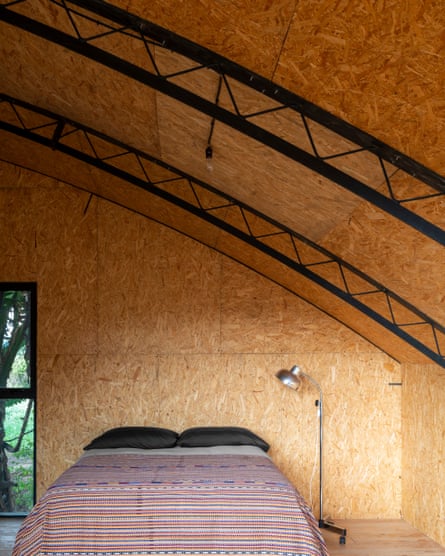
Deep in the Mexican countryside of Valle de Bravo – a lush escape about two hours’ drive from Mexico City – Emiliano Garcia and Helene Carlo found the perfect spot to build an eco home. Partners in life and in ASPJ, a Mexican architecture and landscape design studio, the couple had a burning question: can we build more sustainably and cheaper, and in a way that can be widely copied?
“It was important for us to prove its feasibility and to be able to make our structure replicable, not only a one-of-a-kind,” says Garcia. The couple are keen for this type of building to become the rule rather than the exception.
La Lomita is named for its hilltop position, from where it looks out on to the picturesque surrounding mountains from its secluded spot, and is accessed by a small dirt road. The structure is distinguished by an unusual single arched roof and an open facade with corrugated metal finishing that loosely evokes the image of an aircraft hangar, but there are many other experimental features meticulously planned by Garcia and Carlo that are not immediately obvious.
“Being able to take weight off the building, bringing it to half of what it would normally be in a conventional build, was a really successful outcome,” says Garcia. The main structural element is a concrete cube that encloses two bathrooms and the staircase. It supports the rest of the house, which is built primarily in wood. “This means we’re not intervening heavily in the foundation by digging deep into the ground and building concrete slab layers. Here, we managed to separate the house from the ground, only attaching it to the necessary structural points.”

A second critical aspect for Garcia and Carlo was the traceability of materials and controlling as much as possible their impact on the environment. To build the columns, floors and walls – which amounts to 70% of the house – they used recycled laminated wood made from boxes for the transport of car parts in Volkswagen and Audi factories. “This is FSC-certified wood from Europe and we’re giving it a second use as OSB [oriented strand board], a material that is gaining popularity these days.”
The laminated wood’s raw quality not only brings a cool industrial vibe that matches other elements, it has incredible thermal properties that make it very practical. The moderate climate in Valle de Bravo, with an average yearly temperature of 15C, means that summers can get very warm, while winters are chilly and humid.
To support the thermic qualities of OSB, a “bioclimatic” approach in designing the structure makes sun and wind part of the project, helping to regulate temperature indoors. The roof is made in arcotecho (a self-supporting roofing system using steel arches and frames) and is recycled, having been recovered from an unfinished project. Its curve marks the exact path of the summer sun, which limits the amount of heat entering the home. To cope with colder weather, it was important to orient the house facing south. This determined the design of the facade, which is mostly open, and the positioning of a front pond to reflect the sun and boost the heat entering the house.

On the north-facing rear, the house is almost totally enclosed by a metal contour, except for small long windows. When it’s too hot, opening some windows perfectly regulates the temperatures inside with a gentle airflow. When it’s cold and insulation is needed, the entirely closed back and double glazed windows are sufficient to keep the place warm.
The couple’s approach to the interior was to source secondhand items or make things themselves: the blue cabinet in the main living area is a vintage piece that they repainted themselves, and the stove is also vintage. The dining table they made from recycled wood, while the chairs have been restored.
Their experimentation extends to water management as well. They designed a biodigester with the Danish company Superflex to recycle all their water and produce gas at the same time. Next, Garcia and Carlo created a system to further clean the water, filtering it through plants and then using it for irrigation. They also catch rainwater, primarily from the roof, which they filter for house use. Drinking water requires an extra filtration step.
At the moment, La Lomita is not completely off-grid, taking some electricity from the municipality because of Mexico’s overproduction of solar energy, but for the sake of making the project 100% self-sufficient, solar panels will be installed in coming months.
“This kind of home can be replicated and custom-insulated depending on the climate,” says Garcia, “proving that it is possible to build more sustainably and more affordably was a big deal for us.”
For more information, go to aspj.mx



